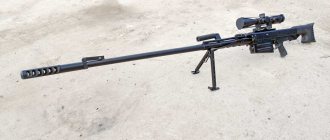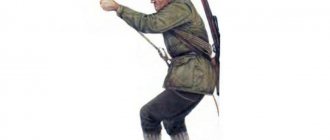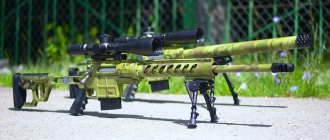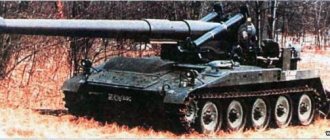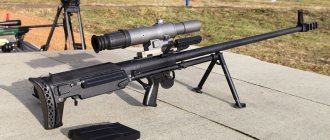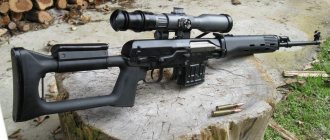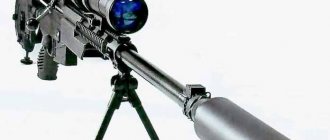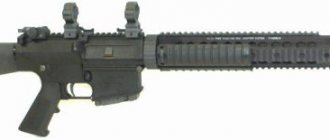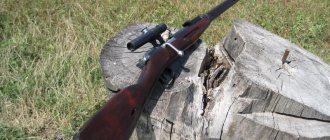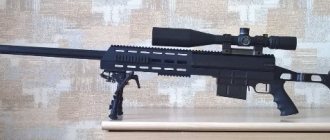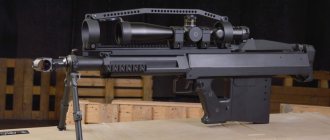When talking about the best sniper shots, the first thing to take into account is the range of the shot and the accuracy of the hit. Guided by these criteria , Guns&Ammo magazine compiled a rating of the eight longest and most accurate shots officially registered. Today, more than ever, modern weapons make it possible to surprise distant targets. However, one of the record-breaking shots was made more than 50 years ago, which speaks of the importance of the skills and professionalism of the entire sniper. All ranges are given in yards (1 yard = 91 cm). In eighth place in the ranking is the shot of an overseas participant in the war in Iraq, Sergeant Major Jim Gilliland (1367 yards). Shot fired from a standard M24 rifle using standard 7.62x51mm NATO ammunition in 2005. In seventh place is a shot by an unknown attorney of the Norwegian military contingent in 2007 during armed conflict in Afghanistan. Rifle - Barrett M82A1. Ammo: Raufoss NM140 MP. Range - 1509 yards. Number six is British Army Corporal Christopher Reynolds and his August 2009 accurate shot at 2,026 yards. Rifle - Accuracy International L115A3. Ammo - .338 Lapua Magnum LockBase B408. The target hit was a Taliban commander nicknamed "Mullah", responsible for a number of attacks on coalition troops in Afghanistan. For his shot, the corporal was awarded a medal from the hands of Queen Elizabeth II of Great Britain. Number five - Sergeant Carlos Hatchhawk, shot at 2500 yards. The date is February 1967, the time of the Vietnam discord. The historic shot that made the sergeant a hero of his time was fired from an M2 Browning machine gun. Ammo - .50 BMG. Hatchcock is still a legend in the overseas army - he ranks fourth on the list of snipers who hit the highest number of targets. At one time, the Vietnamese placed a bounty of 30,000 US dollars on his head. Fourth place - overseas Sergeant Brian Kremer and shot at 2515 yards. Date: March 2004. Weapon - Barrett M82A1. Ammo: Raufoss NM140 MP. During his two years in Iraq, Kremer made two successful shots with a range of more than 2,350 yards. Third place (bronze) went to Canadian, Corporal Arron Perry. Shot range: 2526 yards. Date: March 2002. Weapon - McMillan Tac-50. Ammo: Hornady A-MAX.50 (.50 BMG). Second place (silver) - a shot at 2657 yards, again by Canadian Corporal Rob Furlong, which coincides in date with Arron Perry's record. The weapons and ammunition are the same.
In first place (gold) is the unsurpassed record of Briton Craig Harrison. During the Afghan Contention in November 2009, he fired his best double shot at 2,707 yards. The defeat of the target was documented - two Taliban machine gunners were killed in stages. This record makes Harrison the best of all time.
Russian sniper Andrei Ryabinsky, in a team with spotters Yuri Sinichkin, Evgeniy Titov and Vladimir Grebenyuk, set a world record for precision shooting range with a sniper rifle. According to a blog post by Russian arms company Lobaev Arms, the accurate shot range was 4,210 meters. For accurate shooting, the SVLK-14S “Twilight” rifle was used, deliberately designed for the maximum permissible range of an accurate shot. According to Ryabinsky, the bullet covered a distance of 4210 meters in 13 seconds. For accurate shooting at such a distance, experts considered a lot of factors, including wind, atmospheric pressure, derivation, temperature and the rotation of the Earth. Derivation is the deflection of a spinning bullet after the shot. The deflection occurs perpendicular to the plane of the oncoming air flow. The displacement of the bullet coincides with the direction of the rifling of the barrel of the weapon from which it was fired. For the SVD sniper rifle, the deflection is up to 60 centimeters when shooting at a target at a distance of one kilometer. Many modern small arms sights consider derivation in design. In particular, the PSO-1 for SVD is deliberately mounted so that after the shot the bullet goes slightly to the left. In artillery, this phenomenon is either included in the firing tables, or is also taken into account constructively. The SVLK-14S sniper rifle is available in 3 calibers: .408 Chey Tac (10.36 x 77 mm), .338 Lapua Magnum (8.6 x 70 mm) and .300 Winchester Magnum (7.62 x 67 mm). For shooting at high distances, .408 caliber weapons were used. Shooting was carried out at a target one meter wide and one meter high. The length of the rifle is 1430 millimeters with a barrel length of 900 millimeters. The rifle is equipped with a longitudinally sliding bolt. The mass of SVLK-14S is 9.6 kilograms. The accuracy of fire from a rifle is 0.3 arc minutes. The previous world record for the range of an accurate shot was set from the overseas M300 sniper rifle. It was 4157 meters. Meanwhile, in June 2022, a Canadian sniper set the record for a verified effective accurate shot taken in combat. Using a 12.7 mm TAC-50 rifle, a Canadian in Iraq killed a militant at a distance of 3540 meters. Correction: The news originally stated that the SVLK-14S sniper rifle is equipped with a five-round magazine. In reality, another rifle of this family, the SVLK-14M, is equipped with such a magazine. The SVLK-14S was specifically left single-shot by the developers to maintain maximum accuracy and firing range. We apologize to the readers. Vasily Sychev A sniper's shot can not only hit the enemy, but also sow terror and panic in his ranks. Behind just one shot there can be years of preparation and weeks of waiting for the right moment. Often, spending a long time in the wild and waiting for a target, a sniper must possess not only all the survival skills, but also the knowledge not to lose concentration in a dangerous moment. At such a moment, a lot depends on what kind of weapon he has in his hands. Modern sniper rifles are sometimes real marvels of engineering and are capable of surprising objects at a distance of more than 2 kilometers. We have selected for you the 10 most famous sniper rifles - from those that helped at Stalingrad to those used in modern special operations.
"Three-line" Mosin
In 1931, the Mosin rifle became the first Soviet sniper rifle, having received the “sighting tube” from the Podolsk Optical Plant. The design later underwent certain metamorphoses. The “Three Line” proved to be excellent at short and medium distances during the 2nd World War. Thus, in the Battle of Stalingrad, 98 snipers of the 13th Guards Rifle Division killed 3,879 German soldiers and officers.
The ASVK, or large-caliber military sniper rifle, was developed in the USSR back in the late 1980s. This 12-kilogram rifle is capable of surprising lightly armored and unarmored military vehicles at a distance of up to a kilometer. You can’t even talk about defeating a person - a bullet fired from this weapon will fly one and a half kilometers at a speed of approximately 850 meters per second.
Vintorez
This silent sniper rifle was developed in the same 1980s as the ASVK. It was intended for special units. Later, after the collapse of the USSR, the screw cutter was vigorously used during the First and Second Chechen Wars, as well as during the Georgian-Ossetian discord. The length of the rifle does not reach 90 centimeters, and its weight is less than 3 kilograms.
After domestic examples, it’s time to move to the USA, where in 1990 the Calico M951S rifle was developed, wonderfully surprising targets at medium distances. Its features include a high rate of fire and an exceptionally large magazine that can hold up to 100 rounds. Which, however, is not surprising, the tea model was made on the basis of the Calico M960 submachine gun.
Dragunov sniper rifle
The Dragunov self-loading rifle is the best example of a product from the Izhevsk Machine-Building Plant. This sniper gun was developed from 1958 to 1963 by a group of designers led by Evgeniy Dragunov. Over the years, “Dragunov” has been modified many times and still has aged a little. Currently, the SVD is considered as a solid but standard rifle for a line warrior who is a sniper in a unit. Nevertheless, at a distance of up to 600 meters, it is still a harsh weapon for exterminating enemy personnel.
CheyTac m200 "Intervention"
CheyTac m200 “Intervention” - one of the components of the overseas sniper system CheyTac LRRS - has been produced in various modifications since 2001. This model is distinguished by its ability to surprise targets at large distances (about 2 kilometers) with high accuracy. It can be said that “Intervention” has become a real phenomenon in the world of computer shooters. So in the popular game “Call of Duty: Modern Warfare 2” it is present as one of the most powerful types of weapons.
AMP Technical Services DSR-1
The German DSR-1 rifle can be called the most accurate, however, only when shooting under perfect conditions - using specialized cartridges and the absence of wind. It belongs to the police or anti-terrorist weapons and is used by European formations such as GSG-9. Highly professional military personnel are not very fond of the DSR-1 - it is susceptible to dirt and sand, and in real combat operations, say when there is an explosion nearby, it misfires.
Accuracy International AS50
The AS50 was first demonstrated to the general public in January 2005 at the ShotShow 2005 exposition in the USA. The 1369mm equipment weighs 14.1 kilograms without optics and ammunition and is intended primarily for special operations. The sniper can instantly fold or unfold it and bring it into combat readiness. High accuracy of shooting over long distances, adaptation for mounting various, including night, optics make the AS50 one of the best modern examples of sniper rifles.
This rifle has a fascinating history of creation. The M82 was assembled by American Ronnie Barrett in his garage back in 1982. After the refusal of a number of leading arms companies, he decided to launch small-scale production for the domestic market. After 7 years, the Swedish Army acquires 100 rifles from Barrett Firearms, and after that the US Army pays attention to them during Operations Desert Hurricane and Desert Shield. Today, the Barett M82 is in service with several dozen countries and can conduct targeted fire at a distance of approximately 2 km. The rifle is present in a number of famous films and computer games up to GTA V, which once again confirms its authority.
Accuracy International Arctic Warfare
Another brainchild of the mythical English company Accuracy International Ltd., which has had no equal since 1980. The UK uses it for military purposes, and modified models are used by special forces and police. However, on the civilian weapons market this rifle is positioned as a “sporting” rifle - for example, in Russia a few years ago it was allowed to be purchased in a gun store for approximately 20 thousand bucks. The AWM fired the furthest recorded combat sniper shot in history, with British soldier Craig Garrison firing at a distance of 2,475 metres. The “civilized trace” of this weapon can also lay claim to a record - the AWM is mentioned in a number of the most famous computer shooters, including Call of Duty, Battlefield and, finally, Counter-Strike. Many people underestimate the work of a sniper, however, in fact, he is faced with some of the most difficult tasks during combat operations. In difficult conditions, it is necessary to track a target for a long time and at the same time not give away your location to the enemy. In addition, you have to shoot from a long distance, which only the best of the best can do. It is about the best snipers who managed to hit the target from the longest distances that we will talk further. Christopher Reynolds Distance : 1,852 meters The most accurate shot was fired by British sniper Christopher Reynolds. His target was a field commander nicknamed "Mullah", who took responsibility for several recent terrorist attacks in the region. Reynolds destroyed the boss with one movement of his finger, for which he received a medal from the hands of the Queen of Great Britain herself. South African sniper Distance : 2,124 meters One of the snipers of the regular army of South Africa (the warrior’s name is classified) achieved stunning efficiency: for several days the soldier “picked off” 5-6 rebels of the M23 group - all at a distance of about 2 kilometers.
Carlos Hatchcock Distance : 2,286 meters In 1967, artillery sergeant Carlos Hatchcock set an extremely strange record: instead of a sniper rifle, this master used an M2.50 Browning machine gun, equipped, for laughs, with an optical sight. Carlos was able to shoot a Viet Cong at a distance of more than two kilometers, which to this day remains a record for mechanical weapons.
Brian Kremer Distance : 2,285 meters Sergeant Brian Kremer was deployed to Iraq with the 2nd Overseas Ranger Battalion. The mission of this detachment is still classified - it is only known that the shot of the sniper Kremer brought him the fame of the best shooter of each operation.
Arron Perry Distance : 2,413 meters Another Canadian sniper distinguished himself in Operation Anaconda. Arron Perry was able to shoot an Afghan with an RPG at a distance of more than two kilometers, and Perry pulled the trigger, guided only by the random reflection of the sun on the enemy gun.
Bruno Turcotte Distance : 2,414 meters Bruno Turcotte was part of a group of Canadian peacekeepers conducting an operation on the dangerous Afghan slopes. His shot saved an entire detachment of overseas infantrymen: the soldiers were climbing the mountain and did not see the machine gunner, who was ready to open fire. Bruno's immediate reaction earned him the rank of master corporal.
Corporal Harrison Distance : 2,462 meters British sniper, Corporal Horse Craig Harrison, served in an infantry support detachment. The battle that took place in November 2009 made this brave guy a real legend among his colleagues. Harrison was able to neutralize the driver, shooter and passenger of an Afghan pickup truck equipped with a machine gun with three shots. Three out of 3 are at a distance of approximately two and a half kilometers.
This story began several years ago, when Russian shooter and manufacturer of high-precision long-range rifles Vlad Lobaev saw a video on YouTube where cheerful old men from Texas hit a target with a rifle at a distance of 3,600 yards (3,292 m).
Vlad decided to take on the challenge and compete with the Americans. Fortunately, he had his own weapons factory, Lobaev Arms, at hand. The best from PM for Defender of the Fatherland Day The Americans shot from a custom-made ultra-long-range rifle of rare caliber .375 CheyTac. By that time, Lobaev’s company was already mass-producing the ultra-long-range rifle SVLK-14 “Twilight” in the even rarer and stronger .408 CheyTac caliber, which allows sniper shooting at distances of over 2 km. For the record, they took a special custom “Twilight” with a titanium chassis and firing pin, with a barrel length of 720 mm and a weight of more than 9 kg. In April 2015, on a field in the Kaluga region (there are easily no multi-kilometer shooting ranges in Russia), Lobaev’s team used this rifle to hit a target at a distance of 3400 m after the sighting shots. The video with the record was posted on YouTube. The Americans reacted calmly: they say, okay, let's continue the duel in absentia. High rifle SVLK-14 “Dusk”
Subsonic
Not only the Americans reacted: a French sniper from the Foreign Legion, after long training sessions, hit a target at a distance of 3600 m, but, apart from an article in a small specialized magazine, there is no information about this record, no one posted videos. The Americans also surpassed the mark, first 3600, and then 4000 yards (3657 m). This video in Lobaev’s company was actually studied under a microscope: some parameters of the shot did not match, the flight time did not match the initial speed and angle of the bar. Nothing has changed in ballistics, but several hundred meters have been added. This does not happen, but because the competition was originally conceived as a competition of gentlemen, the Lobaevites decided to continue to shoot with the Americans in good faith. And win by knockout - hit from four kilometers. Ultra-long-range shooting for shooters is considered to be shooting at a distance where at the end of the trajectory the bullet travels at deep subsonic levels, since with supersonic everything is clear - there ballistics are calculated easily, using primitive mathematical methods. But subsonic ballistics is considered more difficult, and what is most unpleasant is that in this mode some physical processes occur that make shooting at ultra-long distances difficult. Firstly, the result of re-stabilization appears. The linear speed slows down per 1000 m, say, three times - from 900 m/s to 300 m/s. And the speed of rotation of the bullet is 5-10% each. At subsonic speeds the speed is even lower, but the rotation speed is still the same. This leads to the fact that all the design and manufacturing flaws of the bullet begin to come out, which greatly affects the dispersion. In addition, at low speeds, errors in assessing wind and weather conditions become noticeable. The 2nd factor is turbulence in the bottom part at deep subsonic levels. At speeds slightly less than 300 m/s this has no skeptical significance, but at ranges greater than 2 km it greatly affects accuracy. There is only one method to combat these phenomena - to develop a bullet design with a different bottom design.
Typical ultra-long range shooting applications require increased bullet weight and more ideal aerodynamics. Lobaev set his first record with a standard D27 bullet, an analogue of the Lost River, widely known in the West. These are elongated, solidly turned bullets for long-range shooting, also called Ultra VLD. They were no longer suitable for new records. If you follow the path of increasing bullet weight, you will need to change each cartridge - either increase the chamber, use the latest progressive burning powder, or switch to a different caliber altogether. A different caliber (Browning.50 or domestic 12.7 x 108 mm) is a transition to a different class and a completely different weapon with all the ensuing consequences: different barrels, bolts, receivers, dimensions, weight and a significant increase in recoil, at which the purchase There is no longer any question of pleasure from shooting. Lobaev decided not to deviate from the old cartridge case and .408 CheyTac caliber, and not to change either the dimensions or weight of the weapon. He managed to develop a heavier 30 gram D30 bullet while remaining within the boundaries of the standard cartridge. This was also done because the cartridge is quite accessible and anyone can try to repeat the achievement. The design of the bullet was also modified: it began to resemble a long elongated spindle with two pointed ends, which made it possible to achieve a virtually flawless ballistic indicator of one. This required a metamorphosis of the rifle design, more rapid rifling pitch, in order to stabilize the longer and heavier bullet. If the typical pitch of rifling in the 408 caliber is thirteen, then on a tall rifle Lobaev decided to use ten. Despite the fact that the initial speed of the new bullet was lower (875 m/s for the D30 versus 935 m/s for the D27), at 2 km it had a more flat trajectory.
“At this distance they won’t even hit an elephant.”
The names of the first shooters, famous for the longest shots, remained in history solely thanks to their victims - high-ranking military leaders. The first attested ultra-long shot dates back to the era of the Napoleonic Wars - its victim was the French general, Baron Auguste de Colbert. In 1809, he was killed by a rifleman of the 95th British Rifle Division, a certain Thomas Plunkett - he was in fifth position.
It is believed that Plunket killed Colbert from an incredible distance of 600 meters at the time. And to prove that the hit was not accidental, he killed the general’s adjutant with another shot - however, this is rather a legend. There is no exact information about what kind of weapon the British shooter used.
Some sources say that Plunkett fired a standard 1722 smoothbore musket, the famous Brown Bess. But it is more likely that the long-range shot was fired from a rifled fitting, which by that time had appeared in the British army. By the way, British snipers of the 19th century - military, hunters, athletes - often used a rather unusual technique - they shot while lying on their back, resting the barrel on the shin of a bent leg. It is believed that it was from this position that Plunkett shot de Colbert.
Tom Plunkett
“At this distance they won’t even hit an elephant,” these were the last words of American General John Sedgwick - a second later he fell from a sniper’s bullet. This is already the American Civil War of 1861-1865. At the Battle of Spotsylvania, Sedgwick, who fought on the side of the United States, controlled artillery fire. The Confederate riflemen, seeing the enemy commander, began hunting for him, the staff officers lay down and invited their commander to go to cover. The enemy positions were separated by a distance of approximately one kilometer. Sedgwick, considering this distance safe, began to shame his subordinates for their timidity, but did not have time to finish - a bullet from an unknown Sergeant Grace hit him in the head. This is perhaps the longest shot of the 19th century, although it is impossible to say whether it was an accident or not. This is the fourth position in the ranking.
Descriptions of long-range shots - at a distance of half a kilometer - are also found in the chronicles of the War of Independence and the American Civil War. Among the North American militias there were many good hunters, and they used long-barreled, large-caliber hunting rifles and rifles as weapons.
Lateral support
One of the main challenges when shooting high is that it is impossible to limitlessly raise the bar of an optical sight. When shooting at such distances, the rifle has large elevation angles, as when shooting overhead, actually like a howitzer. At the top point of the trajectory, the bullet travels at an altitude of several hundred meters. No scopes allow making such adjustments for aiming; therefore, for high shooting, special rails for the scope are used. However, it is impossible to raise the bar endlessly: the muzzle device begins to block the aiming line. This is precisely what confused Lobaev in the last American record: the angle of inclination of the bar did not correspond to the correction required for such a distance. Lobaev spotted a solution to this problem at the artillery, where the sight had long ago been moved to the left of the barrel. The solution is primitive, but no one in the world has used it before Lobaev. If you carefully look at the photograph, you can see that the sight on Lobaev’s tall rifles runs to the left of the barrel. What turned out to be more comfortable for shooting: you don’t have to throw your head back and you can take the optimal position.
Lobaev's know-how is the side mount of the sight for ultra-long-range shooting. A year ago it was forbidden to even photograph it. This system can also be used by troops: when shooting at long distances, it helps to make do with available Russian sights.
Rifle from the garage
The Americans never made rifles from machine guns. But in 1982, former police officer Ronnie G. Barrett designed a 12.7 mm sniper rifle in a garage workshop - it was later designated the Barrett M82. The inventor offered his development to monsters of the arms market, such as Winchester and FN, and after the latter refused, he established his own small-scale production, registering the company Barrett Firearms. Barrett's first clients were hunters and civilian lovers of high-precision shooting, and at the very end of the 80s, a batch of 100 M82A1 rifles was purchased by Swedish troops, followed by the Swedes in which the American military became interested in Barrett's rifle. Today, the word "Barrett" has virtually become synonymous with a large-caliber precision rifle.
Roni Barrett
Another “high-precision” caliber of 12.7x99 millimeters began to be produced in the mid-80s by the small American company McMillan Bros. The rifle was called the McMillan TAC-50 - today they are used by special units in the USA and Canada.
The full benefits of large-caliber precision weapons were revealed in Iraq and Afghanistan. With the outbreak of hostilities in the Middle East, snipers of the Western coalition began to update range records almost every year. In 2002, in Afghanistan, Canadian Arron Perry, using a McMillan TAC-50 rifle, hit a Mujahid from a distance of 2,526 yards (just over 2.3 thousand meters), thereby breaking Hathcock's long-standing record. In the same year, his compatriot Rob Furlong made a successful shot at 2657 yards (just over 2.4 thousand meters). These two shots are in second position.
American sniper Brian Kremer came close to the shooters from Canada - in March 2004 in Iraq, he hit a target at a distance of 2300 meters with a Barrett M82A1 rifle. During his two years of service in Iraq, Kremer is believed to have fired two successful shots with a range of more than 2,100 meters.
Craig Harrison
In first place is the currently unsurpassed record of Briton Craig Harrison. During an operation in Afghanistan in November 2009, at a range of 2470 meters, he destroyed two Taliban machine gunners and their machine gun. According to Craig himself, before the three effective shots he had to make nine more sighting shots.
Tags: war • shot • history • accuracy • review • ultra-long range • snipers • accuracy
On the 2nd try
They were going to break the record last summer in the fields near Krasnodar. For this purpose, a giant target measuring 10 x 10 m was made so that we could actually shoot. No one knew how a bullet behaved at such distances, and there were no precise mathematical models. It was only clear that the bullets would enter the ground in the target area approximately vertically, therefore the target stood at a huge angle. Another difficulty was that the ground was wet during the shooting, so it was necessary to hit the target correctly: traces of hitting the ground at such low speeds and approximately vertical angles are not visible. Unfortunately for each team, the record failed the first time: they couldn’t even hit such a huge target. While they were preparing for the next round, the Americans posted a video on the Internet with a 4 km record. It became clear that we needed to shoot even further. Every year that has passed, Lobaev and his team conjured over the rifle and new bullets, without actually giving out information about the plan, for fear of jinxing the world record, constantly approaching the secret milestone, first taking 4170 m, then 4200. And in October of this year they succeeded in the unimaginable: the famous shooter and promoter Andrei Ryabinsky hit a target measuring 1 x 1 m from a distance of 4210 m. For such a shot it was necessary to take into account a huge number of factors, including the rotation of the Earth - the bullet spent 13 seconds in the air! As the record holder himself said, it took him eight years to achieve this shot. So now the ball is in overseas territory. Or, more positively, a bullet.
Carlos "White Feather"
The first half of the twentieth century did not bring new deadly records, at least those that would become part of history and glorify the shooter. During the First and Second World Wars, the skill of snipers was determined not by the ability to make an ultra-long shot, but by the number of enemies killed. It is known that one of the most successful snipers of all time, the Finn Simo Häyhä (he killed up to 705 enemy soldiers) preferred to shoot from a distance of no more than 400 meters.
Carlos Hathcock
For new range records, a weapon was needed that significantly exceeded the characteristics of standard sniper rifles. Such a weapon was the Browning M2 machine gun with a caliber of 12.7x99 millimeters (50 BMG), developed in the early 30s of the last century. During the Korean War, American soldiers began to use it as a sniper rifle - the machine gun was equipped with an optical sight and could fire single fire. With its help, a veteran of the Vietnam War, American Sergeant Carlos Norman Hathcock II, set a range record that stood for 35 years. In February 1967, an American destroyed the enemy from a distance of 2286 meters - third position. From his M2 sniper, Hathcock was guaranteed to hit a tall target with single shots from a distance of 2000 yards (a little more than 1800 meters), that is, approximately twice as much as the standard army “high-precision” M24 in calibers 308 Win (7.62x51 millimeters) and 300 Win Mag (7.62x67 millimeters).
The Vietnamese nicknamed Hathcock “White Feather” - supposedly, despite the requirements of camouflage, he always attached a feather to his hat. Some sources claim that the North Vietnamese command placed a reward of 30 thousand dollars on the sniper's head. It is noteworthy that Hathcock received his highest award, the Silver Star, not for sniper shooting, but for saving his comrades from a burning armored personnel carrier.
McMillan TAC-50 rifle
Inspired by Hathcock's successes, the US military department created a special commission that studied the possibility of creating a heavy sniper rifle based on Browning.
